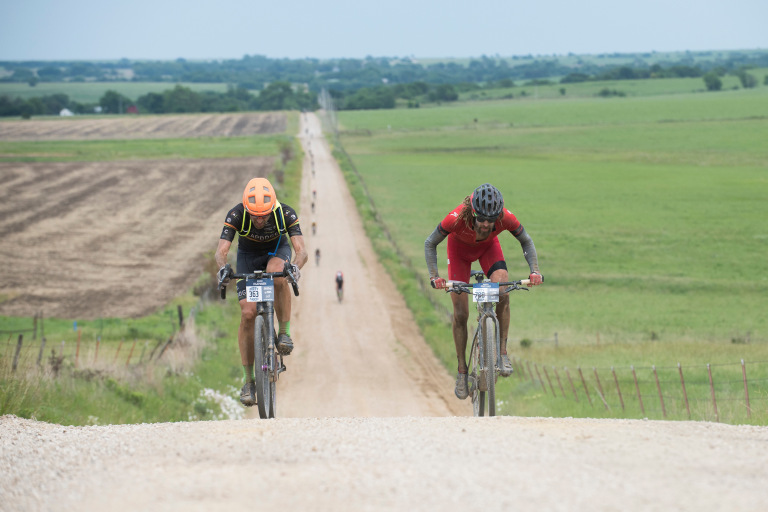As gravel races of 100+ miles have become the norm, we felt like it was time to repost this old article from way back in 2014, when doing a 4 day MTB stage race or a 200 mile gravel race still felt a little wild, not something you’d do as part of a standard season. As we tackle bigger and bigger events, recovery becomes more and more important. Let’s dig in!
How Often can You Do Epic Stuff?
As more and more racers are turning to endurance or ultra-endurance races and adventures, it’s easier than ever to stack back-to-back events. But how much time do you really need to recover from a long race or a 300-kilometer bike-packing trip before you go big again (e.g. an Everesting attempt)?
Here, we’re talking about figuring out objectively just how fatigued you are and how long you need to recover before your next adventure to allow for continued fitness and health.
The length of time it takes to recover from efforts is an important concept that endurance athletes, myself included, often do not give enough attention. After completing the Trans-Sylvania Epic in 2014 I was faced with another opportunity to be patient and let the fitness accumulate. Seven days of 2-4 hours hard mountain biking, sleeping/living out of a tent (definitely out of my norm), and then a food born illness after the 7-day race ended. I had a lot of recovering to do.
While it was tempting to get back to racing the next weekend and training that week there is a reality that exceeding normal training volume, intensity as well as accumulating sleep dept and a fairly significant illness require extended recovery time … but how much and what signs help indicate it is time to get back at it?

Click here to book a phone consult to discuss your training data and personal variables
How to Quantify the Level of Fatigue?
The simplest way to look at fatigue is: how far out of your normal day-to-day did you go, and how far out of your normal state are you now? For most of the participants at endurance events (>3 hours or multi-day), the race days are hard, that is they are more than their normal day of training. It is not uncommon for the race/stage durations and training stress to be 3 or more times the usual. Knowing we have done more than usual it is without debate that we will need to recover and be patient after but for how long?
Training Stress Score (TSS) = Intensity x Duration
Training Peaks uses Training Stress Score (TSS) is an attempt to represent how hard a ride is taking into account the duration and the intensity relative to your Functional Threshold Power (FTP). The classic example is 100 TSS is about a 1 hour time trial or around 2-3hrs of riding at endurance pace. By extension, 1 hour of endurance ends up around 35-50tss, 1-hour race might get very close to 100tss, and a 4-hour race might be 200-350tss points. Some programs, such as training peaks, will create and compare several rolling averages based on your weekly tss (ATL or ‘fatigue’) and a Chronic load (6 weeks and called ‘fitness score’) and an ‘acute’ number. These ratios and averages can be compared to try and avoid doing ‘too much too soon’ and ending up injured, sick, or over-trained.
What happens when you do something really epic? The TSS for the race day(s) will be high (relative to your fitness/normal) and you see a negative Training Stress Balance (TSB), which is the difference between your normal and the recent training stress (think of it as a gauge of ‘too much, too soon’). If TSB gets quite negative (>-40??) then you have an indication you are out of your normal and in risky territory. As you see the TSB recover over several easy days you might resume training at 0-15 TSB, which is not an exact science but that’s a general idea.
- TSS less than 150 – low (recovery generally complete by the following day)
- 150-300 – medium (some residual fatigue may be present the next day, but gone by the second day)
- 300-450 – high (some residual fatigue may be present even after 2 days)
- Greater than 450 – very high (residual fatigue lasting several days likely)
FEELINGS
How you feel, while seemingly ‘subjective’ or not exact, is actually well supported as an indicator of your training readiness. These internal measures are better in many ways than TSS which only captures your power data. So the fact I cut myself racing, got sick afterward, wasn’t sleeping, was descending really bumpy mountain bike trails are not accounted for but certainly could affect recovery time. This is where feelings/emotions or ‘subjective measures help as they tend to change with your recovery status.
Motivation, stress, soreness, and happiness/grumpiness are among metrics that can help detect over-training before any other bio-markers (i, ii ). If you are finding yourself not sleeping, easily angered, grumpy, slow to get out the door to ride, or replacing hard rides with ‘tempo’ you likely have some ‘feelings’ that indicate you are not recovered. Ease of getting out of bed in the morning, fatigue on stairs, vertical jump, and sleep quality are other metrics that are commonly used to try and isolate changes from baseline. The challenge with all of these metrics is how/when to listen to them as guides in your daily training but detecting when you are out of your normal is the tricky part.
We couple these subjective (feelings) measures with resting HR and HRV using the HRV4Training App, which syncs to training peaks and does a good job of suggesting when some of these measures are out of YOUR normal. (read about Molly’s experience with HRV).
EPIC Recovery
Lynda Wallenfels has a great blog article on the times she feels it takes to recover as well, I have kept this article bookmarked for many years to review when I think I am being too cautious with recovery for clients, or for myself. She estimates recovery for 100 milers at 2-3 weeks recovery, for 24-hour solos at 3 weeks and for MTB Stage races at 3 weeks. I read this post to mean that it is possible to do 100 miles on back-to-back weekends or 2-3 weeks apart but it may not mean you get fitter. Performance is not necessarily adaptation.
Lynda makes the point that recovery to race again is different than recovering to train to improve and then race again.
The hay in the barn analogy can be helpful to reflect on how big your barn is and how much hay you have. Do you have reserves for this event/challenge? Or did you do something epic recently and there are signs that your barn is empty or in disrepair (e.g. those feelings discussed above, signs of injury, illness or risky training load data, very low heart rate, etc.) The mid-season fatigue or burnout is commonly due to running out of hay. For a motivated athlete, it takes a lot of discipline and patience to train:recover thinking long term versus use up all of the hay since they have it.
In my opinion, most of us do not need to do 100 miles (or KM) to get fitter, we can adapt to much lower stimulus but its not as epic.

Other Factors (age, previous training, goals, lifestyle)
While TSS is nice it can leave out the difference in the athlete before the race and the intensity in which the race is performed. Elites are well conditioned for the events they are elite in so they often are cooling down after events and doing easier training the next day. Many age-groupers are very fatigued at the finish and for days to weeks after events as their race day is so EPIC relative to their normal and their actual race day is much longer (time in the saddle, time in the sun, etc). Age, daily ‘recovery’ environment (e.g. do you wake up for kids), and other factors can prolong recovery from EPIC events for adult-athletes. Pros often have youth, a large fitness ‘base’, and schedules optimized for recovery on their side.
We need to be careful that we don’t take too many elite concepts and apply them to age-group/masters/regular people with jobs
Increasingly the concept of Energy Availability is an issue even at the pro ranks. The epic rides are awarded on social media but the risks for over-training/under-fueling are very large and it is only in the long-term that issues around body image, bone health, and general health are detected, often not linked back to excessive training loads.
Go Forth and Do Epic Things
Not sure what your post-adventure recovery should look like?
Click here to book a phone consult to discuss your training data and personal variables
NOTE: This post was originally published back in 2014 after a 5-day MTB stage race, and has been edited slightly for clarity





